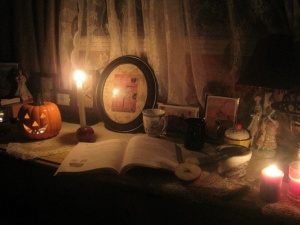Our Scottish ancestry is rich in Celtic traditions
The Celts follow an Earth based seasonal wheel. The Celtic year is divided into two halves, the dark beginning with Samhain and the light beginning with Beltane. In between these are Imbolc and Lughnasadh/Lammas. These key points of the Celtic year were recognized as doorways, when the veil between the worlds are thinnest.
These quarters are further divided by the solstices and equinoxes: Winter Solstice, Spring Equinox, Summer Solstice, and Autumn Equinox. These were referred to as the Albans.
We’re all familiar with the solstices as they are noted as the longest (summer) and shortest (winter) days of the year. The word is derived from the Latin sol meaning sun and sistere meaning to stand still.
Equinoxes also occur twice a year, when day and night are equal lengths. In fact, the word is derived from the Latin aequus meaning equal and nox meaning night.
 Today is Samhain (pronounced sav-en in Scotland, sow-een in Wales, or sow-in in Ireland)
Today is Samhain (pronounced sav-en in Scotland, sow-een in Wales, or sow-in in Ireland)
Samhain (summer’s end) is a cross quarter day between Mabon and Yule falling on November 1st but like other Celtic festivals it is celebrated on its eve, October 31st. Consider it Celtic New Year’s Eve and New Year’s Day. It signals the close of harvest and the start of the winter season. It is the Day of the Dead for the Celts, Egyptians, and Mexicans – the night we remember our loved ones and honor our ancestors.
The veil between the world of the dead and the world of the living is said to be its thinnest. Spirits of loved ones have more power and ability to visit us. (Be sure to leave out a plate of food and a glass of wine for wandering spirits.)
One Celtic tradition (mostly in the Scottish Highlands) young men would run the boundaries of their farms after sunset with blazing torches to protect the family from the Faeries and malevolent forces free to walk the land and cause mischief that night.
Decorate your home with photographs of dead loved ones, pumpkin lanterns, oak leaves, apples, nuts, and sage. Scents to include are nutmeg, mint, and sage.
Some activities to try:
- Create an ancestors altar by gathering photographs, heirlooms, and other mementos of deceased family and friends. Thank them for being a part of your life.
- Reflect on your life over the last year. Consider your accomplishments and growth, challenges and adventures, and the changes you want going forward.
- Share stories of your ancestors, learn about your family history. Contact older relatives and ask them to share memories of family members now dead and record them in some way. (And share them with us here!)
- Take a meditative walk, observe the colors, aromas, sounds, and other sensations of the season. Experience yourself as part of the Circle of Life.
- Prepare a Samhain dinner and include a place setting at your table. Offer a bit of each beverage consumed and a bit of each food served. Invite your ancestors to dine with you. After the feast, place the plate and cup outside as an offering for the dead.


Thanks for this information, Sherri! I don’t relate to the connection with the dead as our ancestors did; but, am glad to have gained a better understanding!
LikeLike
Samhain is why the world has Hallowe’en, well, those who celebrate it anyhow.
I don’t know if it’s fact or not, but I’ve also heard Samhain is why the Catholic church named November 1st All Saints Day. I’m inclined to believe it as the Catholic church has done that with a number of pagan celebrations, such as Yule (which is next in this series).
I love learning about our history be it personal or cultural. Glad you find it interesting Aunt Vivian.
LikeLike